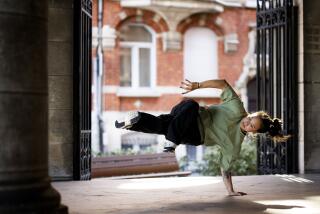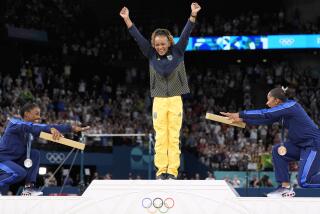X Games’ safety a question as tricks get more dangerous
- Share via
At X Games 17 on Thursday in downtown Los Angeles, Jackson Strong won the Moto X best trick contest with a trick no one had pulled off in that event’s history: a front flip.
The Australian native had practiced it for three years on a dirt bike and landed it here in a gold-medal performance.
But soon after the event, he looked ahead.
“One day, somebody is probably going to be doing a double front flip on a dirt bike,” Strong said. “I hope I’m not around when that happens.”
The culture of action sports has long been for its athletes to push higher, harder, faster, farther.
At the X Games, the athletes push even more when competing against their sport’s finest on their sport’s biggest stage. Combine that culture and that stage, and serious injuries are bound to occur.
In the same event Strong won, action sports star Travis Pastrana suffered a broken right foot and ankle when he attempted a trick he has failed to complete for years.
Later Thursday night, BMX rider Chad Kagy fell from about 45 feet into a quarterpipe and broke his right femur.
These injuries represent a small sample size, but Bill Moore, a performance psychologist who has worked with dozens of athletes, said that given the culture of action sports and of the X Games, proper oversight is a must.
“If left to their own devices, athletes will continue to push it and suffer consequences down the line,” said Moore, president of Moore Performance Consulting. “That is the culture of what these guys are coming from. What’s happened is, the tricks have outgrown the culture.”
Jamie Bestwick, who won his fifth straight gold medal in the BMX freestyle vert Friday, described how the games have changed.
“Years ago, you could pump the ramp and settle for one big trick and maybe win the contest,” he said. “Now it’s back-to-back-to-back, you’re stringing big tricks with filler tricks and then going back to big tricks. It’s really tough, and it’s really easy to have a lapse in concentration.”
Like all sports, the X Games is certainly much different from when it began, but Moore said it’s unlike other sports.
“The difference with these guys is mistakes really matter,” Moore said.
A small mistake can result in disaster, such as when Jake Brown attempted a 540-degree spin above the 27-foot tall quarterpipe wall in the skateboard big air competition in 2007.
Later, Brown said he was too far left as he approached the quarterpipe. He ended up plummeting from about 45 feet in the air onto the flat part of the ramp, a landing that could have killed him.
Scott Guglielmino, ESPN’s senior vice president of programming and Global X, said that when an audience that isn’t too familiar with action sports sees a crash, “they think that it’s more inherently dangerous than it is.”
“They’re athletes, not daredevils,” he added.
Nate Adams, who won the gold medal in Moto X freestyle Friday, agreed that athletes do think about their well-being, but said he competes in about 15 action sports events annually and none compare to the X Games in terms of pressure.
“There’s two, three times as many people carted out at X Games as any other contest because people, even if they’re doing a new trick, they’re doing it bigger, they’re just trying to extend it more,” Adams said.
“So people just end up crashing here because they’re just trying that much harder because this event has so much weight on it: our sponsorship, our money, our livelihood, everything
Adams continued: “This is our life’s work. What else are we going to do? I’m not going to lay carpet with my dad.”
Part of the issue, Moore said, is these athletes compete in an event that encourages this culture partly to cater to sponsors, advertisers and fans, who all want to see these athletes push their limits.
“Then you step back and say, who’s in charge here? Is the wolf watching the chicken coop?” Moore said.
“And that’s where you have a conflict of interest, the people putting it on being the ones looking out for safety. That’s hard. That’s a lot to ask.”
Guglielmino said ESPN takes every step to ensure safety.
Moreover, he said, “I don’t think that ESPN is at conflict at all. I think it’s very clear what we do.”
Dr. David Chao, ESPN medical director for the X Games, said ESPN has more than 20 certified athletic trainers and four doctors on site and cooperates fully with local medical centers.
twitter.com/baxterholmes
More to Read
Go beyond the scoreboard
Get the latest on L.A.'s teams in the daily Sports Report newsletter.
You may occasionally receive promotional content from the Los Angeles Times.










